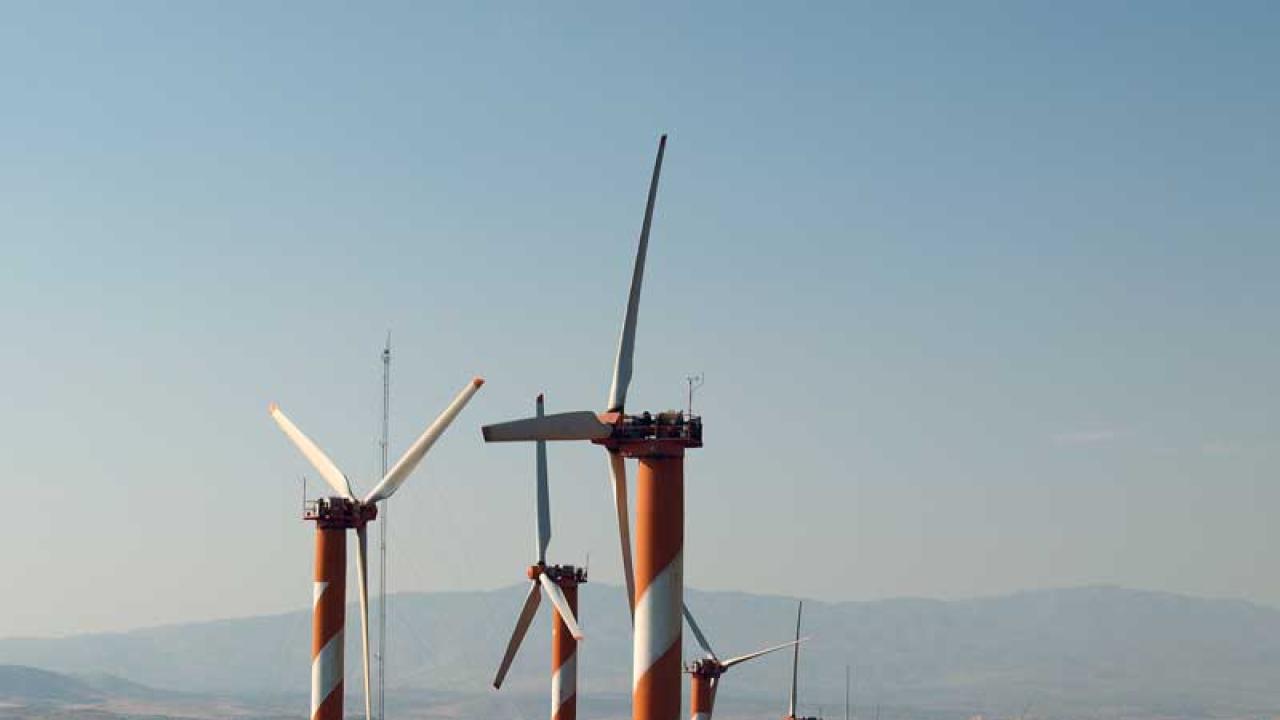
To save our planet from massive climate change-caused catastrophe, keeping average global temperature rise under two degrees Celsius is essential. Turning to renewable energy sources like solar and wind farms can help rid us of our current dependence on fossil fuels, as harnessing only a small fraction of the wind and solar energy available on Earth would be enough to meet the world’s energy demands. But what happens to local climate and weather patterns when an area hosts a massive solar farm, or a huge wind farm? A team of climatologists, including ICTP’s Fred Kucharski, set out to find out, following the idea from Eugenia Kalnay, a visitor of ICTP a decade ago, that solar panels and windmills in the Sahara should both lead to increased precipitation.
Large-scale wind and solar farms in the Sahara Desert, the models reveal, would indeed increase both rain (more than doubling the current levels) and vegetation. This huge change is due to the changes in land surface properties that the farms would create. The team used multiple climate models working together to follow the domino path of how these changes could affect the climate, including for the first time many more details on how vegetation can fuel the climate response to solar and wind farms. "Dynamic vegetation is not a typical factor in climate models," says Ning Zeng, a professor at the University of Maryland Department of Atmospheric and Oceanic Science and one of Kucharski's collaborators, when he was recently at ICTP to lecture a summer school, along with Eviatar Bach, another co-author, who was attending. "Its importance has not been appreciated."
How important it can be is demonstrated by this paper, published on 7 September in the journal Science. Previous modeling studies considering the potential climate impact of large wind and solar farms used prescribed (constant), rather than dynamic vegetation in their models of the world, without incorporating how vegetation responds to changing local conditions. In those studies, plants and trees didn't vary as other factors caused the local climate to change. With dynamic vegetation included in the model, details like changes in surface reflectivity, known as albedo, due to increased plant cover in the desert, could be taken into account.
The team focused on the Sahara Desert, and the neighboring transition zone between desert and wooded savanna known as the Sahel, for several reasons, including that they have a large potential supply of wind and solar energy. The Sahara is the largest desert in the world, and is sparsely inhabited, with the land unfit for farming or raising livestock. Installing very large wind or solar farms in the Sahara, could provide energy to the populations of the nearby Middle East and Europe, which both have huge current energy demands, and sub-Saharan Africa, where the energy demand is rapidly growing. That energy could also be used for desalination facilities to provide water, and selling the energy could contribute to the economic growth of the region, one of the poorest in the world. The Sahara Desert has also been expanding over several decades due to climate change and other factors, and these farms could stop the expansion or even reverse it. "Cave paintings of grass, animals, and trees have been found in the Sahara," says Zeng. "Maybe it could look like that again."
The main model used for this project was developed at ICTP by Kucharski and collaborators: SPEEDY, a type of climate model known as a general circulation model, which mathematically describes the circulation of the atmosphere. SPEEDY was coupled with VEGAS, a land model that includes many details of vegetation dynamics, developed by Zeng. "The coupled model is quite realistic," says Kucharski. As it turns out, including dynamic vegetation is key to understanding what can happen with large solar or wind farms: the paper found a feedback mechanism that depends on vegetation dynamics and increases the simulated precipitation massively.
"It's a huge effect, a doubling of the precipitation levels in the Sahara," says Zeng. "I'm still somewhat surprised at how important it is." The mechanism of the effect is slightly different for wind farms and solar farms, but both involve a positive vegetation feedback loop. The farms decrease the surface reflectivity (solar farms) or the surface roughness (wind farms) of the area, increasing rising motion of air and precipitation. More precipitation leads to more vegetation being able to survive, and that vegetation cover further reduces the surface reflectivity, starting the loop all over again. The size of the effect shows how much models using static vegetation would underestimate the temperature and precipitation impacts of the farms. The large effect worried the authors initially, as the extra moisture for the increased precipitation in the region could potentially cause drought somewhere else. But as it turns out, the extra moisture appears to be drawn mostly from the ocean.
The team has several further aspects it wants to understand more. "In future research, we would also like to focus on specific areas, and use a higher resolution model," says Zeng.
The current results suggest that building wind and solar farms in the desert, at a scale large enough to power the entire world, would have a beneficial, not detrimental, impact on climate and sustainable development efforts. "These farms could cover the world's energy demand," says Kucharski. "The potential is huge, so it's encouraging that they would have not a disastrous effect but a very beneficial one on the local climate."
“Climate model shows large-scale wind and solar farms in the Sahara increase rain and vegetation” by Yan Li, Eugenia Kalnay, Safa Motesharrei, Jorge Rivas, Fred Kucharski, Daniel Kirk-Davidoff, Eviatar Bach, and Ning Zeng. Science, 2018 September 7. DOI:10.1126/science.aar5629
---- Kelsey Calhoun













